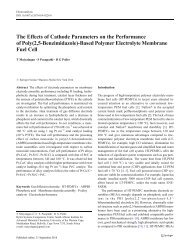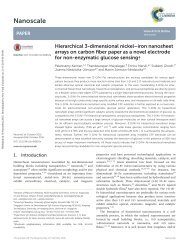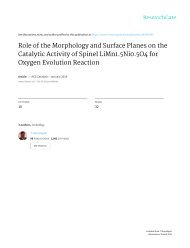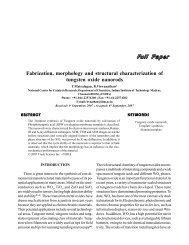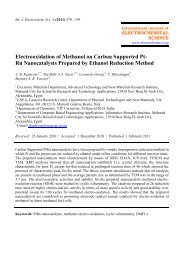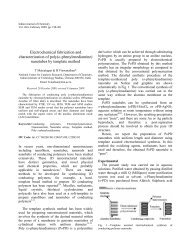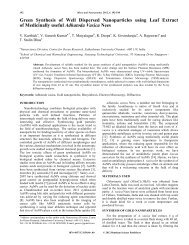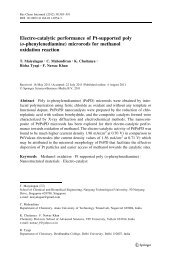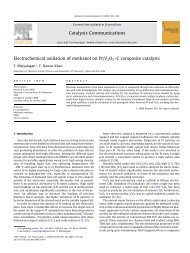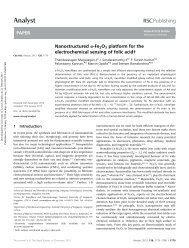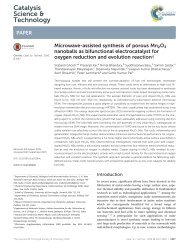Electro-oxidation of methanol on TiO2 nanotube supported platinum electrodes
Create successful ePaper yourself
Turn your PDF publications into a flip-book with our unique Google optimized e-Paper software.
Copyright © 2006 American Scientific Publishers<br />
All rights reserved<br />
Printed in the United States <str<strong>on</strong>g>of</str<strong>on</strong>g> America<br />
Journal <str<strong>on</strong>g>of</str<strong>on</strong>g><br />
Nanoscience and Nanotechnology<br />
Vol.6, 2067–2071, 2006<br />
<str<strong>on</strong>g>Electro</str<strong>on</strong>g>-Oxidati<strong>on</strong> <str<strong>on</strong>g>of</str<strong>on</strong>g> Methanol <strong>on</strong> TiO 2<br />
Nanotube Supported Platinum<str<strong>on</strong>g>Electro</str<strong>on</strong>g>des<br />
T. Maiyalagan, B. Viswanathan ∗ , and U. V. Varadaraju<br />
Department <str<strong>on</strong>g>of</str<strong>on</strong>g> Chemistry, Indian Institute <str<strong>on</strong>g>of</str<strong>on</strong>g> Technology Madras, Chennai 600036, India<br />
TiO 2 <strong>nanotube</strong>s have been synthesized using anodic alumina membrane as template. Highly dispersed<br />
<strong>platinum</strong> nanoparticles have been <strong>supported</strong> <strong>on</strong> the TiO 2 <strong>nanotube</strong>. The <strong>supported</strong> system<br />
has been characterized by electr<strong>on</strong> microscopy and electrochemical analysis. SEM image shows<br />
that the <strong>nanotube</strong>s are well aligned and the TEM image shows that the Pt particles are uniformly<br />
distributed over the TiO 2 <strong>nanotube</strong> support. A homogeneous structure in the composite nanomaterials<br />
is indicated by XRD analysis. The electrocatalytic activity <str<strong>on</strong>g>of</str<strong>on</strong>g>the <strong>platinum</strong> catalyst <strong>supported</strong> <strong>on</strong><br />
Delivered by Ingenta to:<br />
University College Cork<br />
IP : 143.239.65.56<br />
Sat, 29 Jul 2006 16:20:05<br />
TiO 2 <strong>nanotube</strong>s for <str<strong>on</strong>g>methanol</str<strong>on</strong>g> <str<strong>on</strong>g>oxidati<strong>on</strong></str<strong>on</strong>g> is found to be better than that <str<strong>on</strong>g>of</str<strong>on</strong>g> the standard commercial<br />
E-TEK catalyst.<br />
Keywords: TiO 2 Nanotubes, Template Synthesis, Catalyst Support, Methanol Oxidati<strong>on</strong>.<br />
1. INTRODUCTION<br />
Fuel cells operating by the electrochemical <str<strong>on</strong>g>oxidati<strong>on</strong></str<strong>on</strong>g> <str<strong>on</strong>g>of</str<strong>on</strong>g><br />
hydrogen or <str<strong>on</strong>g>methanol</str<strong>on</strong>g>, as fuels at the anode and reducti<strong>on</strong><br />
<str<strong>on</strong>g>of</str<strong>on</strong>g> oxygen at the cathode are attractive power sources due<br />
to their high c<strong>on</strong>versi<strong>on</strong> efficiencies, low polluti<strong>on</strong>, light<br />
weight, and high power density.While <str<strong>on</strong>g>methanol</str<strong>on</strong>g> <str<strong>on</strong>g>of</str<strong>on</strong>g>fers<br />
the advantage <str<strong>on</strong>g>of</str<strong>on</strong>g> easy storage and transportati<strong>on</strong> in comparis<strong>on</strong><br />
to hydrogen oxygen fuel cell, its energy density<br />
(∼2000 Wh/kg) and operating cell voltage (0.4 V) are<br />
lower than the theoretical energy density (∼6000 Wh/kg)<br />
and the thermodynamic potential (∼1.2 V). 1 2 However,<br />
the fuel cells could not reach the stage <str<strong>on</strong>g>of</str<strong>on</strong>g> commercializati<strong>on</strong><br />
due to the high cost which are mainly associated with<br />
the noble metal loaded <strong>electrodes</strong> as well as the membrane.<br />
In order to reduce the amount <str<strong>on</strong>g>of</str<strong>on</strong>g> Pt loading <strong>on</strong> the <strong>electrodes</strong>,<br />
there have been c<strong>on</strong>siderable efforts to increase the<br />
dispersi<strong>on</strong> <str<strong>on</strong>g>of</str<strong>on</strong>g> the metal <strong>on</strong> the support.Pt nanoparticles<br />
have been dispersed <strong>on</strong> a wide variety <str<strong>on</strong>g>of</str<strong>on</strong>g> substrates<br />
such as carb<strong>on</strong> nanomaterials, 3 4 Nafi<strong>on</strong> membranes, 5 6<br />
polymers, 7 8 polymer-oxide nanocomposites, 9 threedimensi<strong>on</strong>al<br />
organic matrices, 10 and oxide matrices. 11–18<br />
Most <str<strong>on</strong>g>of</str<strong>on</strong>g>ten the catalyst is dispersed <strong>on</strong> a c<strong>on</strong>venti<strong>on</strong>al<br />
carb<strong>on</strong> support and the support material influences the<br />
catalytic activity through metal support interacti<strong>on</strong>.Dispersi<strong>on</strong><br />
<str<strong>on</strong>g>of</str<strong>on</strong>g> Pt particles <strong>on</strong> an oxide matrix can lead, depending<br />
mainly <strong>on</strong> the nature <str<strong>on</strong>g>of</str<strong>on</strong>g> support, to Pt <strong>supported</strong> oxide system<br />
that shows better behaviour than pure Pt.On the other<br />
hand, if the oxide is not involved in the electrochemical<br />
∗<br />
Author to whom corresp<strong>on</strong>dence should be addressed.<br />
reacti<strong>on</strong>s taking place <strong>on</strong> the Pt sites, it might just provide<br />
a c<strong>on</strong>venient matrix to produce a high surface area<br />
17 18<br />
catalyst.<br />
Titanium dioxide is an attractive system for electrocatalysis,<br />
since if used as the support for metallic catalysts<br />
or electrocatalysts, it may enhance their catalytic<br />
activity <strong>on</strong> the basis <str<strong>on</strong>g>of</str<strong>on</strong>g> str<strong>on</strong>g metal support interacti<strong>on</strong><br />
(SMSI). 23 24 TiO 2 is an effective photocatalysts for <str<strong>on</strong>g>oxidati<strong>on</strong></str<strong>on</strong>g><br />
<str<strong>on</strong>g>of</str<strong>on</strong>g> <str<strong>on</strong>g>methanol</str<strong>on</strong>g>. 19 Pt/TiO 2 is stable in acidic or alkaline<br />
medium, which has higher active surface area than Pt<br />
and shows high activity for oxygen reducti<strong>on</strong>. 15 20 21 There<br />
are several articles, which deal with the <str<strong>on</strong>g>methanol</str<strong>on</strong>g> <str<strong>on</strong>g>oxidati<strong>on</strong></str<strong>on</strong>g><br />
reacti<strong>on</strong> <strong>on</strong> TiO 2 <strong>supported</strong> Platinum catalyst.<br />
17 18<br />
Titanium mesh <strong>supported</strong> <strong>electrodes</strong> showed high activity<br />
<strong>on</strong> the <str<strong>on</strong>g>methanol</str<strong>on</strong>g> <str<strong>on</strong>g>oxidati<strong>on</strong></str<strong>on</strong>g>, therefore appears to be<br />
a promising alternative to carb<strong>on</strong>-<strong>supported</strong> catalysts. 22<br />
More important in the present case, Pd/TiO 2 <strong>nanotube</strong> has<br />
been recently shown to act as a good catalyst for the <str<strong>on</strong>g>oxidati<strong>on</strong></str<strong>on</strong>g><br />
<str<strong>on</strong>g>of</str<strong>on</strong>g> <str<strong>on</strong>g>methanol</str<strong>on</strong>g>. 23<br />
The present report focuses <strong>on</strong> the efforts undertaken to<br />
develop unc<strong>on</strong>venti<strong>on</strong>al supports based <strong>on</strong> <strong>platinum</strong> catalysts<br />
for <str<strong>on</strong>g>methanol</str<strong>on</strong>g> <str<strong>on</strong>g>oxidati<strong>on</strong></str<strong>on</strong>g>.The catalyst <strong>supported</strong> <strong>on</strong><br />
metal oxide <strong>nanotube</strong>s yields a better dispersi<strong>on</strong> and shows<br />
better catalytic activity.TiO 2 <strong>nanotube</strong>s <str<strong>on</strong>g>of</str<strong>on</strong>g> the anatase<br />
form have been synthesized by sol gel method using<br />
anodic aluminium oxide (AAO) as the template.TiO 2<br />
<strong>nanotube</strong>s were used to disperse the <strong>platinum</strong> particles<br />
effectively without sintering and to increase the catalytic<br />
activity for <str<strong>on</strong>g>methanol</str<strong>on</strong>g> <str<strong>on</strong>g>oxidati<strong>on</strong></str<strong>on</strong>g>.The tubular morphology<br />
and the oxide nature <str<strong>on</strong>g>of</str<strong>on</strong>g> the support have influence <strong>on</strong> the<br />
dispersi<strong>on</strong> as well as the catalytic activity <str<strong>on</strong>g>of</str<strong>on</strong>g> the electrode.<br />
Titanium dioxide is also known to have str<strong>on</strong>g metal<br />
J. Nanosci. Nanotechnol. 2006, Vol. 6, No. 7 1533-4880/2006/6/2067/005 doi:10.1166/jnn.2006.324 2067
<str<strong>on</strong>g>Electro</str<strong>on</strong>g>-Oxidati<strong>on</strong> <str<strong>on</strong>g>of</str<strong>on</strong>g> Methanol <strong>on</strong> TiO 2 Nanotube Supported Platinum <str<strong>on</strong>g>Electro</str<strong>on</strong>g>des<br />
Maiyalagan et al.<br />
support interacti<strong>on</strong> with Pt particles.The present communicati<strong>on</strong>,<br />
deals with the preparati<strong>on</strong> <str<strong>on</strong>g>of</str<strong>on</strong>g> highly dispersed<br />
<strong>platinum</strong> <strong>supported</strong> <strong>on</strong> TiO 2 <strong>nanotube</strong>s, the evaluati<strong>on</strong> <str<strong>on</strong>g>of</str<strong>on</strong>g><br />
the catalytic activity for the <str<strong>on</strong>g>methanol</str<strong>on</strong>g> <str<strong>on</strong>g>oxidati<strong>on</strong></str<strong>on</strong>g> <str<strong>on</strong>g>of</str<strong>on</strong>g> the<br />
<strong>electrodes</strong> and a comparis<strong>on</strong> with the catalytic activity <str<strong>on</strong>g>of</str<strong>on</strong>g><br />
c<strong>on</strong>venti<strong>on</strong>al <strong>electrodes</strong>.<br />
2. EXPERIMENTAL DETAILS<br />
2.1. Materials<br />
All the chemicals used were <str<strong>on</strong>g>of</str<strong>on</strong>g> analytical grade.Titanium<br />
isopropoxide (Aldrich) and 2-propanol (Merck) were<br />
used as received.Hexachloroplatinic acid was obtained<br />
from Aldrich.20 wt% Pt/Vulcan carb<strong>on</strong>s were procured<br />
from E-TEK.Methanol and sulphuric acid were<br />
obtained from Fischer chemicals.The alumina template<br />
membranes (Anodisc 47) with 200 nm diameter pores<br />
were obtained from Whatman Corp.Nafi<strong>on</strong> 5 wt% soluti<strong>on</strong><br />
was obtained from Dup<strong>on</strong>t and was used as received.<br />
2.2. Synthesis <str<strong>on</strong>g>of</str<strong>on</strong>g> Pt/TiO 2 Nanotubes<br />
Titanium isopropoxide (5 mL) was added to 25 mL <str<strong>on</strong>g>of</str<strong>on</strong>g><br />
2-propanol (mole ratio [Ti 4+ ]/[2-propanol] = 1:20).The<br />
soluti<strong>on</strong> was stirred for 3hatroom temperature (298 K).<br />
The alumina template membrane was dipped into this soluti<strong>on</strong><br />
for 2 min.After removal from the soluti<strong>on</strong>, vacuum<br />
was applied to the bottom <str<strong>on</strong>g>of</str<strong>on</strong>g> the membrane until the entire<br />
volume <str<strong>on</strong>g>of</str<strong>on</strong>g> the soluti<strong>on</strong> was pulled through the membrane.<br />
The membrane was then air-dried for 60 min at 303 K,<br />
and then placed in a furnace (in air) with a temperature<br />
ramp <str<strong>on</strong>g>of</str<strong>on</strong>g> 2 C min −1 to 873 K for 2 h.The temperature<br />
was then decreased at a ramp rate <str<strong>on</strong>g>of</str<strong>on</strong>g> 2 C min −1 to<br />
room temperature (303 K). 24 The TiO 2 /alumina composite<br />
obtained (before the dissoluti<strong>on</strong> <str<strong>on</strong>g>of</str<strong>on</strong>g> template membrane)<br />
was immersed in 73 mM H 2 PtCl 6 (aq) for 12 h.After<br />
immersi<strong>on</strong>, the membrane was dried in air and the i<strong>on</strong>s<br />
were reduced to the corresp<strong>on</strong>ding metal(s) by exposure to<br />
flowing H 2 gas at 823 K for 3 h.The resulting composite<br />
was immersed into 3 M aqueous NaOH for several minutes<br />
to dissolve the alumina template membrane.This procedure<br />
resulted in the formati<strong>on</strong> <str<strong>on</strong>g>of</str<strong>on</strong>g> Pt nanocluster loaded<br />
TiO 2 <strong>nanotube</strong>s.<br />
2.3. Preparati<strong>on</strong> <str<strong>on</strong>g>of</str<strong>on</strong>g> Working <str<strong>on</strong>g>Electro</str<strong>on</strong>g>de<br />
Delivered by Ingenta to:<br />
University College Cork<br />
IP : 143.239.65.56<br />
Sat, 29 Jul 2006 16:20:05<br />
Then the electrode was dried at 353 K and used as the<br />
working electrode.<br />
2.4. Characterizati<strong>on</strong> Methods<br />
The scanning electr<strong>on</strong> micrographs were obtained using<br />
JEOL JSM-840 model, working at 15 keV after the<br />
removal <str<strong>on</strong>g>of</str<strong>on</strong>g> alumina template.For transmissi<strong>on</strong> electr<strong>on</strong><br />
microscopic studies, the <strong>nanotube</strong>s dispersed in ethanol<br />
were placed <strong>on</strong> the copper grid and the images were<br />
obtained using Phillips 420 model, operating at 120 keV.<br />
The X-ray diffracti<strong>on</strong> patterns were obtained <strong>on</strong> a Philips<br />
PW 1820 diffractometer with Cu K (1.54178 Å)<br />
radiati<strong>on</strong>.<br />
2.5. <str<strong>on</strong>g>Electro</str<strong>on</strong>g>chemical Measurements<br />
The catalyst was electrochemically characterized by cyclic<br />
voltammetry (CV) using an electrochemical analyzer (Bioanalytical<br />
Sciences, BAS 100).A comm<strong>on</strong> three-electrode<br />
electrochemical cell was used for the measurements.The<br />
counter and reference <strong>electrodes</strong> were a <strong>platinum</strong> plate<br />
(5 cm 2 ) and a saturated Ag/AgCl electrode respectively.<br />
The CV experiments were performed using 1 M H 2 SO 4<br />
soluti<strong>on</strong> in the presence <str<strong>on</strong>g>of</str<strong>on</strong>g> 1 M CH 3 OH at a scan rate<br />
<str<strong>on</strong>g>of</str<strong>on</strong>g> 50 mV/s.All the soluti<strong>on</strong>s were prepared by using<br />
ultra pure water (Millipore, 18 M).The electrolytes<br />
were degassed with nitrogen before the electrochemical<br />
measurements.<br />
3. RESULTS AND DISCUSSION<br />
The scanning electr<strong>on</strong> microscopic (SEM) image <str<strong>on</strong>g>of</str<strong>on</strong>g> the<br />
TiO 2 <strong>nanotube</strong>s obtained after dissolving the 200 nm alumina<br />
template membrane is shown in Figure 1.It can be<br />
Glassy Carb<strong>on</strong> (GC) (Bas <str<strong>on</strong>g>Electro</str<strong>on</strong>g>de, 0.07 cm 2 ) was polished<br />
to a mirror finish with 0.05 m alumina suspensi<strong>on</strong>s<br />
before each experiment and served as an underlying substrate<br />
<str<strong>on</strong>g>of</str<strong>on</strong>g> the working electrode.In order to prepare the<br />
composite electrode, the <strong>nanotube</strong>s were dispersed ultras<strong>on</strong>ically<br />
in water at a c<strong>on</strong>centrati<strong>on</strong> <str<strong>on</strong>g>of</str<strong>on</strong>g> 1 mg ml −1 and<br />
20 l aliquot was transferred <strong>on</strong> to a polished glassy carb<strong>on</strong><br />
substrate.After the evaporati<strong>on</strong> <str<strong>on</strong>g>of</str<strong>on</strong>g> water, the resulting<br />
thin catalyst film was covered with 5 wt% Nafi<strong>on</strong> soluti<strong>on</strong>.<br />
Fig. 1. SEM image <str<strong>on</strong>g>of</str<strong>on</strong>g> TiO 2 <strong>nanotube</strong>s obtained by sol gel method calcined<br />
at 650 Cfor2h.<br />
2068 J. Nanosci. Nanotechnol. 6, 2067–2071, 2006
Maiyalagan et al.<br />
<str<strong>on</strong>g>Electro</str<strong>on</strong>g>-Oxidati<strong>on</strong> <str<strong>on</strong>g>of</str<strong>on</strong>g> Methanol <strong>on</strong> TiO 2 Nanotube Supported Platinum <str<strong>on</strong>g>Electro</str<strong>on</strong>g>des<br />
A(101)<br />
R(101)<br />
(a) TiO 2 Nanotube<br />
(b) TiO 2 - Degussa<br />
(c) Pt / TiO 2 Nanotube<br />
Intensity ( a.u )<br />
(c)<br />
(b)<br />
(a)<br />
R(110)<br />
A(112)<br />
R(203)<br />
A(103)<br />
Pt<br />
A(103) A(004)<br />
R(211)<br />
A(200)<br />
A(105)<br />
R(220)<br />
A(211)<br />
Fig. 2. TEM images <str<strong>on</strong>g>of</str<strong>on</strong>g> (a) TiO 2 <strong>nanotube</strong>s obtained by sol gel method<br />
calcined at 650 C for 2 h (b) Pt filled TiO 2 <strong>nanotube</strong>s.<br />
20 30 40 50 60<br />
2 theta<br />
seen from the figure that an ordered array <str<strong>on</strong>g>of</str<strong>on</strong>g> <strong>nanotube</strong>s<br />
with uniform diameter and length is formed.The open end<br />
and the hollow nature <str<strong>on</strong>g>of</str<strong>on</strong>g> the TiO 2 <strong>nanotube</strong>s is also c<strong>on</strong>firmed<br />
by transmissi<strong>on</strong> electr<strong>on</strong> microscopy (TEM) image<br />
as shown in Figure 2a.The outer diameter <str<strong>on</strong>g>of</str<strong>on</strong>g> the <strong>nanotube</strong>s<br />
is ca.200 nm, retaining the size and near cylindrical shape<br />
<str<strong>on</strong>g>of</str<strong>on</strong>g> the pores <str<strong>on</strong>g>of</str<strong>on</strong>g> the aluminium oxide template membrane.<br />
The TEM image <str<strong>on</strong>g>of</str<strong>on</strong>g> a Pt/TiO 2 <strong>nanotube</strong> electrode is shown<br />
in Figure 2b, which shows that the Pt particles are highly<br />
dispersed <strong>on</strong> the TiO 2 <strong>nanotube</strong> support.The Pt particle<br />
size was found to be around 3–4 nm while their crystal<br />
structure is c<strong>on</strong>firmed by the XRD method.The optimal Pt<br />
particle size for reacti<strong>on</strong>s in the H 2 /O 2 fuel cell is around<br />
3 nm. 25 The importance <str<strong>on</strong>g>of</str<strong>on</strong>g> the Pt particle size <strong>on</strong> the activity<br />
for <str<strong>on</strong>g>methanol</str<strong>on</strong>g> <str<strong>on</strong>g>oxidati<strong>on</strong></str<strong>on</strong>g> is due to the structure sensitive<br />
nature <str<strong>on</strong>g>of</str<strong>on</strong>g> the reacti<strong>on</strong> and the fact that particles with different<br />
sizes will have different dominant crystal planes and<br />
hence the different intercrystallite distances, which might<br />
influence <str<strong>on</strong>g>methanol</str<strong>on</strong>g> adsorpti<strong>on</strong>.The commercial Pt/C has a<br />
high specific surface area but c<strong>on</strong>tributed mostly by micropores<br />
less than 1 nm and are therefore more difficult to be<br />
fully accessible.It has been reported that the mean value<br />
<str<strong>on</strong>g>of</str<strong>on</strong>g> particle size for 20% Pt/Vulcan (E-TEK) catalyst was<br />
around 2.6 nm. 26 The TiO 2 <strong>nanotube</strong> matrix <str<strong>on</strong>g>of</str<strong>on</strong>g> anatase<br />
form can provide hydroxide i<strong>on</strong>s to remove CO pois<strong>on</strong>ing.<br />
Methanol <str<strong>on</strong>g>oxidati<strong>on</strong></str<strong>on</strong>g> studies <strong>on</strong> the prepared electrode have<br />
been carried out using cyclic voltammetry.<br />
The XRD patterns <str<strong>on</strong>g>of</str<strong>on</strong>g> the Pt/TiO 2 <strong>nanotube</strong>s as well as<br />
P-25 are shown in Figure 3.Rutile and anatase were seen<br />
by XRD in P25 titania, but rutile was not seen in the<br />
TiO 2 <strong>nanotube</strong>s.The diffractograms <str<strong>on</strong>g>of</str<strong>on</strong>g> the synthesized<br />
TiO 2 <strong>nanotube</strong>s mainly bel<strong>on</strong>g to the crystalline structure<br />
<str<strong>on</strong>g>of</str<strong>on</strong>g> anatase TiO 2 .XRD pattern <str<strong>on</strong>g>of</str<strong>on</strong>g> the TiO 2 <strong>nanotube</strong>s evidenced<br />
the presence <str<strong>on</strong>g>of</str<strong>on</strong>g> anatase as the main phase.After<br />
Pt depositi<strong>on</strong>, the colour <str<strong>on</strong>g>of</str<strong>on</strong>g> the TiO 2 <strong>nanotube</strong>s changed<br />
to dark gray and during reducti<strong>on</strong> <str<strong>on</strong>g>of</str<strong>on</strong>g> Pt, oxide reducti<strong>on</strong><br />
takes place and new diffracti<strong>on</strong> peaks are formed.The<br />
presence <str<strong>on</strong>g>of</str<strong>on</strong>g> Pt could be observed at diffracti<strong>on</strong> angle <str<strong>on</strong>g>of</str<strong>on</strong>g><br />
39.8 indexed to (111) plane <str<strong>on</strong>g>of</str<strong>on</strong>g> metallic Pt.However the<br />
peak intensity is relatively weak, presumably due to the<br />
combinati<strong>on</strong> <str<strong>on</strong>g>of</str<strong>on</strong>g> its low c<strong>on</strong>tent and small particle size.<br />
Delivered by Ingenta to:<br />
University College Cork<br />
IP : 143.239.65.56<br />
Sat, 29 Jul 2006 16:20:05<br />
Fig. 3. X-ray diffracti<strong>on</strong> patterns <str<strong>on</strong>g>of</str<strong>on</strong>g> (a) Degussa TiO 2 as a reference,<br />
(b) TiO 2 <strong>nanotube</strong>, and (c) Pt/TiO 2 <strong>nanotube</strong>.<br />
In order to evaluate the electrocatalytic activity <str<strong>on</strong>g>of</str<strong>on</strong>g> the<br />
Pt/TiO 2 <strong>nanotube</strong> <strong>electrodes</strong> for the <str<strong>on</strong>g>oxidati<strong>on</strong></str<strong>on</strong>g> <str<strong>on</strong>g>of</str<strong>on</strong>g> <str<strong>on</strong>g>methanol</str<strong>on</strong>g>,<br />
cyclic voltammetric studies were carried out in 0.5 M<br />
H 2 SO 4 and 1 M CH 3 OH.During the anodic scan, the current<br />
increases due to dehydrogenati<strong>on</strong> <str<strong>on</strong>g>of</str<strong>on</strong>g> <str<strong>on</strong>g>methanol</str<strong>on</strong>g> followed<br />
by the <str<strong>on</strong>g>oxidati<strong>on</strong></str<strong>on</strong>g> <str<strong>on</strong>g>of</str<strong>on</strong>g> absorbed <str<strong>on</strong>g>methanol</str<strong>on</strong>g> residues<br />
and reaches a maximum in the potential range between<br />
0.8 and 1.0 V versus Ag/AgCl. In the cathodic scan, the<br />
re-<str<strong>on</strong>g>oxidati<strong>on</strong></str<strong>on</strong>g> <str<strong>on</strong>g>of</str<strong>on</strong>g> the residues is observed.On the whole, the<br />
behaviour <str<strong>on</strong>g>of</str<strong>on</strong>g> the Pt/TiO 2 <strong>nanotube</strong> <strong>electrodes</strong> was found to<br />
be similar to that <str<strong>on</strong>g>of</str<strong>on</strong>g> Pt.This suggests that the electro<str<strong>on</strong>g>oxidati<strong>on</strong></str<strong>on</strong>g><br />
reacti<strong>on</strong> takes place <strong>on</strong> the Pt nanoparticles, dispersed<br />
<strong>on</strong> the TiO 2 <strong>nanotube</strong>, involves basically the same reacti<strong>on</strong><br />
mechanism.<br />
Fig. 4. Cyclic voltammogram <str<strong>on</strong>g>of</str<strong>on</strong>g> (a) pure Pt, (b) Pt/C, and (c) Pt/TiO 2<br />
<strong>nanotube</strong> in 0.5 M H 2 SO 4 /1 M CH 3 OH run at 50 mV/s (area <str<strong>on</strong>g>of</str<strong>on</strong>g> the<br />
electrode = 0.07 cm 2 ).<br />
J. Nanosci. Nanotechnol. 6, 2067–2071, 2006 2069
<str<strong>on</strong>g>Electro</str<strong>on</strong>g>-Oxidati<strong>on</strong> <str<strong>on</strong>g>of</str<strong>on</strong>g> Methanol <strong>on</strong> TiO 2 Nanotube Supported Platinum <str<strong>on</strong>g>Electro</str<strong>on</strong>g>des<br />
Maiyalagan et al.<br />
Table I. <str<strong>on</strong>g>Electro</str<strong>on</strong>g>catalytic activity <str<strong>on</strong>g>of</str<strong>on</strong>g> various catalysts for <str<strong>on</strong>g>methanol</str<strong>on</strong>g><br />
<str<strong>on</strong>g>oxidati<strong>on</strong></str<strong>on</strong>g>.<br />
Specific activity<br />
Mass activity<br />
<str<strong>on</strong>g>Electro</str<strong>on</strong>g>catalyst (mA cm −2 ) (mA mg −1 Pt)<br />
Bulk Pt 0167 —<br />
Pt/C 13 3.25<br />
Pt/TiO 2 <strong>nanotube</strong> 132 33<br />
The results <str<strong>on</strong>g>of</str<strong>on</strong>g> the voltammetric curves for the <str<strong>on</strong>g>oxidati<strong>on</strong></str<strong>on</strong>g><br />
<str<strong>on</strong>g>of</str<strong>on</strong>g> <str<strong>on</strong>g>methanol</str<strong>on</strong>g> obtained with the Pt/TiO 2 <strong>nanotube</strong>, Pt and<br />
Pt/C (E-TEK) <strong>electrodes</strong> are shown in Figure 3.The<br />
Pt/TiO 2 <strong>nanotube</strong> shows a higher current density <str<strong>on</strong>g>of</str<strong>on</strong>g><br />
13.2 mA/cm 2 compared to Pt/C (E-TEK) <strong>electrodes</strong><br />
(1.23 mA/cm 2 ).The specific activity and the mass activity<br />
for the different <strong>electrodes</strong> are given in Table I.The results<br />
show that the high electrocatalytic activity for <str<strong>on</strong>g>methanol</str<strong>on</strong>g><br />
<str<strong>on</strong>g>oxidati<strong>on</strong></str<strong>on</strong>g> for Pt/TiO 2 <strong>nanotube</strong> electrode.It is evident<br />
that the mass activity observed with the Pt <strong>supported</strong><br />
TiO 2 <strong>nanotube</strong>s shows around ten-fold increase in current<br />
than Pt/C (E-TEK) electrode.The Pt/TiO 2 <strong>nanotube</strong> catalyst<br />
had a better electrocatalytic activity for <str<strong>on</strong>g>methanol</str<strong>on</strong>g><br />
<str<strong>on</strong>g>oxidati<strong>on</strong></str<strong>on</strong>g> when compared with that <str<strong>on</strong>g>of</str<strong>on</strong>g> bulk Pt and Pt/C<br />
(E-TEK) catalysts.This higher catalytic activity can be<br />
mainly attributed to remarkably <strong>platinum</strong> active reacti<strong>on</strong><br />
sites <strong>on</strong> the <strong>nanotube</strong> oxide matrix and the role <str<strong>on</strong>g>of</str<strong>on</strong>g> the TiO 2<br />
<strong>nanotube</strong> facilitates as a path for <str<strong>on</strong>g>methanol</str<strong>on</strong>g> (CH 3 OH) as a<br />
fuel and Prot<strong>on</strong>s (H + ) produced during an electrochemical<br />
reacti<strong>on</strong>.<br />
It is possible that TiO 2 <strong>nanotube</strong> functi<strong>on</strong>s in the same<br />
way as Ru does in Pt-Ru/C catalysts because hydroxide<br />
i<strong>on</strong> species could easily form <strong>on</strong> the surface <str<strong>on</strong>g>of</str<strong>on</strong>g> the TiO 2<br />
<strong>nanotube</strong>s.The formati<strong>on</strong> <str<strong>on</strong>g>of</str<strong>on</strong>g> hydroxide i<strong>on</strong> species <strong>on</strong> the<br />
surface <str<strong>on</strong>g>of</str<strong>on</strong>g> the TiO 2 <strong>nanotube</strong>s transforms CO like pois<strong>on</strong>ing<br />
species <strong>on</strong> Pt to CO 2 , leaving the active sites <strong>on</strong><br />
Pt for further electrochemical reacti<strong>on</strong> has been shown in<br />
Figure 5. 27 28 The participati<strong>on</strong> <str<strong>on</strong>g>of</str<strong>on</strong>g> the TiO 2 <strong>nanotube</strong> support<br />
the high dispersi<strong>on</strong> <str<strong>on</strong>g>of</str<strong>on</strong>g> Pt particles <strong>on</strong> TiO 2 <strong>nanotube</strong><br />
electrode, OH groups generated near the Pt-oxide interface<br />
promote CO removal, and str<strong>on</strong>g metal support interacti<strong>on</strong><br />
(SMSI) could be a reas<strong>on</strong> for enhanced electrocatalytic<br />
29 30<br />
activity <str<strong>on</strong>g>of</str<strong>on</strong>g> <str<strong>on</strong>g>methanol</str<strong>on</strong>g> <str<strong>on</strong>g>oxidati<strong>on</strong></str<strong>on</strong>g>.<br />
Fig. 5. A possible mechanism for the removal <str<strong>on</strong>g>of</str<strong>on</strong>g> CO pois<strong>on</strong>ing intermediates<br />
during <str<strong>on</strong>g>methanol</str<strong>on</strong>g> <str<strong>on</strong>g>oxidati<strong>on</strong></str<strong>on</strong>g> over TiO 2 <strong>nanotube</strong> <strong>supported</strong> Pt<br />
catalysts.<br />
4. CONCLUSIONS<br />
The Pt was deposited <strong>on</strong> TiO 2 <strong>nanotube</strong>s in order to study<br />
the effect <str<strong>on</strong>g>of</str<strong>on</strong>g> the properties <str<strong>on</strong>g>of</str<strong>on</strong>g> the support for <str<strong>on</strong>g>methanol</str<strong>on</strong>g> <str<strong>on</strong>g>oxidati<strong>on</strong></str<strong>on</strong>g><br />
reacti<strong>on</strong>.The Pt/TiO 2 <strong>nanotube</strong> catalyst exhibits a<br />
high electrocatalytic activity for <str<strong>on</strong>g>methanol</str<strong>on</strong>g> <str<strong>on</strong>g>oxidati<strong>on</strong></str<strong>on</strong>g> compared<br />
to the commercial E-TEK catalysts.Overall, the<br />
relative activities are <str<strong>on</strong>g>of</str<strong>on</strong>g> the order Pt/TiO 2 <strong>nanotube</strong>s ><br />
E-TEK > pure Pt.The observed improved catalytic activity<br />
<str<strong>on</strong>g>of</str<strong>on</strong>g> Pt/TiO 2 <strong>nanotube</strong> catalysts can be due to <str<strong>on</strong>g>oxidati<strong>on</strong></str<strong>on</strong>g><br />
<str<strong>on</strong>g>of</str<strong>on</strong>g> CO to CO 2 by the surface hydroxyl groups <str<strong>on</strong>g>of</str<strong>on</strong>g> TiO 2<br />
<strong>nanotube</strong> support which otherwise pois<strong>on</strong> the active Pt<br />
sites.The electr<strong>on</strong>ic interacti<strong>on</strong> between TiO 2 support and<br />
the Pt particles could also be another factor c<strong>on</strong>tributing to<br />
the observed higher activity.Further study <strong>on</strong> the detailed<br />
mechanism and stability <str<strong>on</strong>g>of</str<strong>on</strong>g> the TiO 2 <strong>nanotube</strong> <strong>supported</strong><br />
catalysts are now under progress.<br />
Acknowledgment: We thank the Council <str<strong>on</strong>g>of</str<strong>on</strong>g> Scientific<br />
and Industrial Research (CSIR), India, for a senior<br />
research fellowship to <strong>on</strong>e <str<strong>on</strong>g>of</str<strong>on</strong>g> the authors T.Maiyalagan.<br />
Delivered by Ingenta to:<br />
University College Cork<br />
IP : 143.239.65.56<br />
Sat, 29 Jul 2006 16:20:05<br />
References and Notes<br />
1. B.D.McNicol, D.A.J.Rand, and K.R.Williams, J. Power Sources<br />
83, 47 (2001).<br />
2. L.Carrette, K.A.Friedrich, and U.Stimming, Fuel Cells 1, 5<br />
(2001).<br />
3. C.L.Lee, Y.C.Ju, P.T.Chou, Y.C.Huang, L.C.Kuo, and J.C.<br />
Oung, <str<strong>on</strong>g>Electro</str<strong>on</strong>g>chem. Commun. 7, 453 (2005).<br />
4. T.Maiyalagan, B.Viswanathan, and U.V.Varadaraju, <str<strong>on</strong>g>Electro</str<strong>on</strong>g>chem.<br />
Commun. 7, 905 (2005).<br />
5. M.Watanabe, H.Uchida, and M.Emori, J. Phys. Chem. B 102, 3129<br />
(1998).<br />
6. H.Uchida, Y.Mizuno, and M.Watanabe, J. <str<strong>on</strong>g>Electro</str<strong>on</strong>g>chem. Soc. 149,<br />
A682 (2002).<br />
7. W.T.Napporn, H.Laborde, J.M.Leger, and C.Lamy, J. <str<strong>on</strong>g>Electro</str<strong>on</strong>g>anal.<br />
Chem. 404, 153 (1996).<br />
8. M.T.Giacomini, E.A.Ticianelli, J.McBreen, and<br />
M.Balasubramanian, J. <str<strong>on</strong>g>Electro</str<strong>on</strong>g>chem. Soc. 148, A323 (2001).<br />
9. B.Rajesh, K.R.Thampi, J.M.B<strong>on</strong>ard, N.Xanthapolous, H.J.<br />
Mathieu, and B.Viswanathan, <str<strong>on</strong>g>Electro</str<strong>on</strong>g>chem. Solid-State Lett. 5, E71<br />
(2002).<br />
10. H.B<strong>on</strong>nemann, N.Wald<str<strong>on</strong>g>of</str<strong>on</strong>g>ner, H.G.Haubold, and T.Vad, Chem.<br />
Mater. 14, 1115 (2002).<br />
11. V.Raghuveer and B.Viswanathan, Fuel 81, 2191 (2002).<br />
12. L.F.D’Elia, L.Rincón, and R.Ortíz, <str<strong>on</strong>g>Electro</str<strong>on</strong>g>chim. Acta 49, 4197<br />
(2004).<br />
13. M.I.Rojas, M.J.Esplandiu, L.B.Avalle, E.P.M.Leiva, and V.A.<br />
Macagno, <str<strong>on</strong>g>Electro</str<strong>on</strong>g>chim. Acta 43, 1785 (1998).<br />
14. M.J.Esplandiu, L.B.Avalle, and V.A.Macagno, <str<strong>on</strong>g>Electro</str<strong>on</strong>g>chim. Acta<br />
40, 2587 (1995).<br />
15. V.B.Baez and D.Pletcher, J. <str<strong>on</strong>g>Electro</str<strong>on</strong>g>anal. Chem. 382, 59<br />
(1995).<br />
16. A.Hamnett, P.S.Stevens, and R.D.Wingate, J. Appl. <str<strong>on</strong>g>Electro</str<strong>on</strong>g>chem.<br />
21, 982 (1991).<br />
17. T.Ioroi, Z.Siroma, N.Fujiwara, S.Yamazaki, and K.Yasuda, <str<strong>on</strong>g>Electro</str<strong>on</strong>g>chem.<br />
Commun. 7, 183 (2001).<br />
18. B.E.Hayden and D.V.Malevich, <str<strong>on</strong>g>Electro</str<strong>on</strong>g>chem. Commun. 3, 395<br />
(2001).<br />
19. P.A.Mandelbaum, A.E.Regazz<strong>on</strong>i, M.A.Blesa, and S.A.Bilmes,<br />
J. Phys. Chem. B 103, 5505 (1999).<br />
2070 J. Nanosci. Nanotechnol. 6, 2067–2071, 2006
Maiyalagan et al.<br />
<str<strong>on</strong>g>Electro</str<strong>on</strong>g>-Oxidati<strong>on</strong> <str<strong>on</strong>g>of</str<strong>on</strong>g> Methanol <strong>on</strong> TiO 2 Nanotube Supported Platinum <str<strong>on</strong>g>Electro</str<strong>on</strong>g>des<br />
20. L.Xi<strong>on</strong>g and A.Manthiram, <str<strong>on</strong>g>Electro</str<strong>on</strong>g>chim. Acta 49, 4163<br />
(2004).<br />
21. J.Shim, C.-R.Lee, H.-K.Lee, J.-S.Lee, and E.J.Cairns, J. Power<br />
Sources 102, 172 (2001).<br />
22. E.H.Yu and K.Scott, J. <str<strong>on</strong>g>Electro</str<strong>on</strong>g>chem. Commun. 6, 361<br />
(2004).<br />
23. M.Wang, D.J.Guo, and H.L.Li J. Solid State Chem. 178, 1996<br />
(2005).<br />
24. S.Lee, C.Je<strong>on</strong>, and Y.Park, Chem. Mater. 16, 4292 (2004).<br />
25. K.Kinoshita, J. <str<strong>on</strong>g>Electro</str<strong>on</strong>g>chem. Soc. 137, 845 (1990).<br />
26. E.Antolini, L.Giorgi, F.Cardellini, and E.Passalacqua, J. Solid<br />
State <str<strong>on</strong>g>Electro</str<strong>on</strong>g>chem. 5, 131 (2001).<br />
27. L.Huaxin, J. Mol. Catal. A: Chem. 144, 189 (1999).<br />
28. M.Takeuchi, K.Sakamoto, G.Martra, S.Coluccia, and M.Anpo,<br />
J. Phys. Chem. B 109, 15422 (2005).<br />
29. S.J.Tauster, S.C.Fung, and R.L.Garten, J. Am. Chem. Soc. 100,<br />
170 (1978).<br />
30. S.G.Neophytides, S.Zafeiratos, G.D.Papak<strong>on</strong>stantinou, J.M.<br />
Jaksic, F.E.Paloukis, and M.M.Jaksic, Int. J. Hyd. Energy 30, 393<br />
(2005).<br />
Received: 23 September 2005.Revised/Accepted: 2 February 2006.<br />
Delivered by Ingenta to:<br />
University College Cork<br />
IP : 143.239.65.56<br />
Sat, 29 Jul 2006 16:20:05<br />
J. Nanosci. Nanotechnol. 6, 2067–2071, 2006 2071




